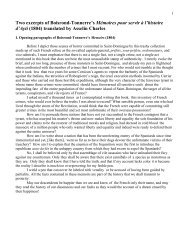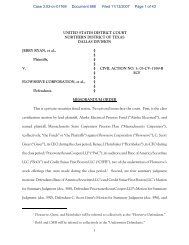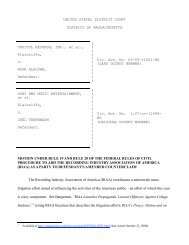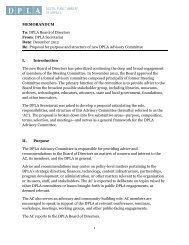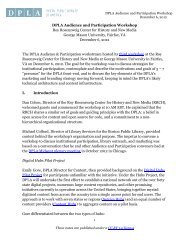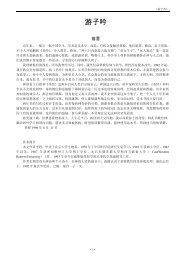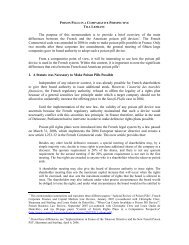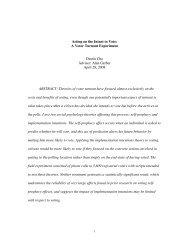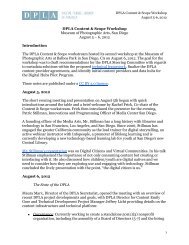Is Positivism a state-centered theory? Detlef von Daniels Introduction
Is Positivism a state-centered theory? Detlef von Daniels Introduction
Is Positivism a state-centered theory? Detlef von Daniels Introduction
Create successful ePaper yourself
Turn your PDF publications into a flip-book with our unique Google optimized e-Paper software.
<strong>Is</strong> <strong>Positivism</strong> a <strong>state</strong>-<strong>centered</strong> <strong>theory</strong>?<br />
<strong>Detlef</strong> <strong>von</strong> <strong>Daniels</strong> *<br />
<strong>Introduction</strong><br />
Legal positivists and their critics nowadays generally share one assumption: the focus<br />
of any analysis of law must be on municipal legal systems. The aim of this paper is to<br />
question this assumption and to explore the consequences of a different view. The<br />
hypothesis is that Hart’s analytical concepts are not restricted to municipal legal<br />
systems. Moreover, it is argued that it is necessary to introduce a third kind of rules,<br />
namely rules that link up different legal systems. Accepting this interpretation will<br />
yield as well consequences for the debate over legal positivism.<br />
The reasons for addressing this issue are both historical and systematic. From<br />
a historical perspective, it is essential to see that municipal legal systems for a long<br />
period of time had neither been the sole nor dominant legal systems, but only one<br />
among others. According to Harold Berman, the Western legal tradition was formed<br />
within a plurality of legal systems requiring the need for mutual recognition. 1 Berman<br />
even argues that during the “Gregorian revolution“ in the 11 th and 12 th century the<br />
Church developed the first modern western legal system, which served as a model for<br />
the development of the notion of government by law. 2<br />
* This paper was presented at the 21st IVR World Congress in Philosophy of Law and Social<br />
Philosophy in Lund (Sweden). I am especially grateful to Leslie Green, Kenneth Himma, and Will<br />
Waluchow for discussion and their criticisms.<br />
1<br />
Harold J. Berman, Law and Revolution. The Formation of the Western Legal Tradition (Cambridge:<br />
HUP, 1983), 292.<br />
2 Opt.cit. 199 - 224.<br />
1
The systematic challenge is to understand the present plurality of legal<br />
systems brought about by creeping internationalization and the blending of different<br />
legal systems in European and on a global scale. 3 A <strong>theory</strong> confined to municipal<br />
systems seems to be incapable of describing those relations. However, no attempt will<br />
be made to analyze the current international and transnational relations between<br />
different legal systems. Instead the subject will be addressed in the form of a<br />
conceptual analysis.<br />
I. The methodological aspect<br />
The starting point of the <strong>state</strong> <strong>centered</strong> perspective in legal positivism is H.L.A. Hart’s<br />
assertion in the Concept of Law 4 that one has to recognize “both clear standard cases<br />
and borderline cases.”(CL 4) The proper task of legal <strong>theory</strong> is then to provide “an<br />
improved analysis of the distinctive structure of a municipal legal system.”(CL 17)<br />
One way to interpret this claim is as a methodological maxim to start with a standard<br />
case and not with an exceptional one. But such a maxim is not very plausible; on the<br />
contrary it is the other way round. In <strong>theory</strong> as well as in practice it is necessary to<br />
investigate difficult or hard cases. According to Karl Popper’s methodological<br />
criteria, a <strong>theory</strong> is ‘true’ if it could not be ‘falsified’ in difficult cases. 5 Exploring<br />
such difficult cases is also a fruitful way to explore new theories as countless<br />
examples in the humanities and philosophy have revealed. Take for example Sigmund<br />
Freud’s discovery of the principles of consciousness by investigating the symptoms of<br />
mentally ill people or Willard van Orman Quine‘s thought experiment of radical<br />
3 On the characteristics of European law in contrast to international regimes see Michael Zürn, Dieter<br />
Wolf. European Law and International Regimes: The Features of Law Beyond the Nation State.<br />
European Law Journal 5 (1999): 272.<br />
4 H.L.A. Hart, The Concept of Law, 2 nd ed. (Oxford: Clarendon Press, 1994), hereinafter cited as CL.<br />
5 The argument is, however, only an analogy as Popper is concerned with the natural sciences.<br />
2
translation, which led him to his <strong>theory</strong> of meaning. It is, therefore, neither a<br />
methodological principle nor a prudent strategy to investigate only standard cases.<br />
Hart’s claim to concentrate on municipal legal systems can also be understood<br />
to mean that those are the most important or mature instances of legal systems. Seen<br />
from today’s perspective, this assertion needs to be reassessed. Today a legal system<br />
that is highly integrated within a supranational legal order and that allows foreign<br />
influences and control even by private actors is considered to be a sign of a developed<br />
or mature legal system. Jürgen Habermas observes only ‘First World’ countries can<br />
afford to be responsive to broad transnational alliances whereas the strict insistence<br />
on sovereignty and refusal of cooperation on the social level is typically a sign of<br />
‘Second World’ countries. 6 Thus, the insistence on investigating municipal legal<br />
systems for the reason that they are the most important or mature does not hold water.<br />
From today’s point of view, the development of municipal legal systems should<br />
instead be regarded as a transitory stage. This does not mean that <strong>state</strong>s or national<br />
legal systems are of no importance but that their significance cannot be presupposed<br />
and needs explaining.<br />
II. Legal systems without secondary rules<br />
If municipal legal systems are not to be taken as the standard case, then another<br />
central idea of Hart needs to be modified, namely that the union of primary and<br />
secondary rules is at the center of the legal system. This alteration is, however, not as<br />
sweeping as it might first appear. Hart himself frequently stresses that only in<br />
examining the standard case of a municipal legal system this union can be found, but<br />
that it is not a “generally necessary condition of the existence of rules of obligation or<br />
3
‘binding’ rules. [It] is not a necessity, but a luxury, found in advanced social<br />
systems.”(CL 235) He stresses this view in the context of international law. Even<br />
though international law resembles a regime of primary rules, as it has no centralized<br />
secondary rules, it is a legal system. Therefore, he can say “the proof that ‘binding’<br />
rules in any society exist, is simply that they are thought of, spoken of, and function<br />
as such. ... It is, of course, true that rules could not exist or function unless a<br />
preponderant majority accepted the rules and voluntarily co-operated in maintaining<br />
them.”(CL 231) Hart explicitly repeats this view later in an article on “Kelsen’s<br />
doctrine of the unity of law” 7 where he concedes to Kelsen that international law can<br />
be conceived as a “decentralized system of law”(KD 340) with no secondary rules.<br />
This seems to contradict with Hart’s earlier view that only the introduction of<br />
secondary rules can be seen as a “step from the pre-legal world into the legal<br />
world.”(CL 94) However, a careful review of the characterization of the primary rules<br />
of obligation in Hart’s example of the “primitive community” reveals that they indeed<br />
qualify as legal rules.<br />
In order to characterize primary rules of obligation as legal rules, it is<br />
necessary to distinguish them from mere personal habits or common behavior, from<br />
moral rules, and standards of etiquette. The internal point of view distinguishes social<br />
rules from mere behavior or habits. Even though Hart struggled hard to refute<br />
behaviorism, the basic insight that it is necessary to take an internal point of view<br />
toward social phenomena (or to engage in Sinnverstehen) can be taken for granted.<br />
Taking an internal point of view alone is, however, insufficient when it comes to<br />
6 See Jürgen Habermas, “Kant’s Idea of Eternal Peace: At two hundred Years Historical Remove,” in<br />
The Inclusion of the Other. Studies in Political Theory (Cambridge, Mass: Polity Press, 1998).<br />
7 H.L.A. Hart, Kelsen’s doctrine of the unity of law,” in Essays in Jurisprudence and Philosophy<br />
(Oxford: Clarendon Press, 1983), hereinafter cited as KD.<br />
4
defining legal rules; for they seem to be still indistinguishable from moral rules and<br />
standards of etiquette. Only when these two kinds of rules are clearly demarcated a<br />
concept of legal rules on the level of primary rules of obligation can be obtained. For<br />
social rules to exist, as defined thus far, two conditions must be present: There must<br />
firstly be a “regular conduct with a distinctive attitude to that conduct as<br />
standard.”(CL 85) Thereby it is secondly presupposed that it is the conduct of a<br />
specific group of people. These groups need not be small, local or even ‘face-to-face’<br />
groups. The groups may also be functional groups, like for instance a religious group<br />
whose members recognize each other all over the world in certain common activities.<br />
Thus, functional groups can have social rules as well.<br />
This preliminary approach is sufficient to provide a categorical distinction to<br />
moral rules. Moral rules (in the strict sense of Hart’s “critical morality”) are not<br />
limited to a particular community but usually apply to all people. They are therefore<br />
not the multilateral rules of a given group but unilateral rules directed at every single<br />
person regardless of the action of others. Certainly, they often coincide with the social<br />
rules of given groups. On the other hand, they can still be distinguished by the simple<br />
test of asking people whether a behavior would still be wrong if the rules of a<br />
community were different. In answer to this question even children at a very young<br />
age know the difference between moral rules and group-relative rules.<br />
However, this distinction is still insufficient when it comes to gleaning legal<br />
rules out of the myriad of primary rules since it does not distinguish between legal<br />
rules and rules of etiquette. Both kinds of rules are multilateral rules of a given group.<br />
However, there remains an urge to refrain from regarding every rule as a legal rule.<br />
Hart merely points out legal rules are “important for the maintenance of social life or<br />
some highly prized feature of it.”(CL 87) Importance itself, though, is not a<br />
5
categorical distinction but only a gradual one. A better distinction is to say that legal<br />
rules demonstrate a reference to justice or — using an expression from Leslie Green<br />
— they are justice-apt. 8 Only with respect to legal rules can one say that it is just to<br />
act in such a manner or to respond to the question why one should do or refrain from<br />
doing something, “For the sake of justice.” It would be odd to invoke this response in<br />
regard to the rules of etiquette. It must be noted that justice in this sense refers only to<br />
the morals of a group. ‘Justice’ in this context, thus, may be replaced with the words<br />
‘the right and proper thing to do according to the standards of the group.’<br />
In this arrangement, there is no centralized system of sanctions though there<br />
can nevertheless be some forms of sanctions. For a system of sanctions can also be<br />
decentralized so that the application of sanctions for the breach of the rules is left to<br />
the community at large. These sanctions may be mild, like simple chastisement for<br />
deviant behavior, but can be equally harsh, as in the expulsion of a member from the<br />
group.<br />
It should be noted that even in this case there is something like a rule of<br />
recognition. It is only similar to the rule of recognition as it is not a secondary rule<br />
used by officials. It is, moreover, not even a rule but rather a practice which is shown<br />
in the way members of the group assess their behavior as lawful.<br />
In his thought experiment, Hart overstressed the gap between the ‘primitive<br />
community’ and the developed legal system, which led him to disregard the primary<br />
rules of obligation as a “primitive or rudimentary form of law.”(CL 86) Nevertheless,<br />
‘primary rules of obligation’ can be used as an analytic notion to describe the law of<br />
decentralized legal systems. It is not only international (customary) law that is such a<br />
8 Leslie Green, "Legal <strong>Positivism</strong>," The Stanford Encyclopedia of Philosophy (Spring 2003 Edition),<br />
ed. Edward N. Zalta . Green,<br />
6
decentralized legal system. The notion applies as well to smaller, functional groups,<br />
e.g. the law of small spiritual groups. In <strong>theory</strong>, Protestant parishes do not accept any<br />
authority of ecclesiastical officials but claim that the spirit is embedded in every<br />
single believer. Speaking in Hart’s terminology, the internal point of view is widely<br />
shared. Nevertheless, those parishes do have rules, e.g. marriage laws even though<br />
they do not have a centralized authority or officials having a special status. From a<br />
historical perspective, this point is obvious as many regulations of the canon law<br />
continued to exist in Protestant lands. 9<br />
III. Institutions defined (or refined) by secondary rules<br />
Secondary rules are thus not necessary for the establishment of a legal system or to<br />
take the step from the pre-legal into the legal world. Instead, they define certain<br />
institutions. One could as well say that they refine institutions since legal rules are<br />
already present in the ‘primitive community’. Therefore, it is important to note that<br />
Hart’s description of the ‘deficits’ of the ‘primitive communities’ are not to be taken<br />
as an absolute. According to Hart’s thought experiment, the ‘primitive community’ is<br />
defective as it has no avenue for recognizing or modifying rules, for settling cases,<br />
and enforcing decisions.(CL 91-99) These remarks need to be qualified. The point is<br />
that these functions cannot be performed very efficaciously. Even in a ‘primitive<br />
community’, rules can be altered if everyone supports the change; cases can be<br />
decided if one party gives in or is obviously in the wrong; and decisions can be<br />
enforced by the community at large. Only, it is not very efficaciously as it requires a<br />
strong and shared sense of appropriateness (justice in the explained sense). For this<br />
however, uses the expression only with regard to whole legal systems with secondary rules.<br />
9<br />
For details see the collected articles in Richard H. Helmholz, ed., Canon Law in Protestant Lands<br />
(Berlin: Duncker & Humblot, 1992).<br />
7
eason, Hart holds that “only a small community closely knit by ties of kinship,<br />
common sentiment, and belief ... could live successfully by such a regime of<br />
unofficial rules.”(CL 92) Thus, secondary rules can make a legal system under certain<br />
circumstances more efficacious by specifying procedures to change, adjudicate,<br />
enforce and recognize rules. For example, secondary rules can make more efficacious<br />
a large but nevertheless united community with pluralistic value orientations. But this<br />
is not true for all circumstances, not even for all modern circumstance. Whether the<br />
international system would be more efficacious with a centralized system of sanctions<br />
is, to say the least, doubtful.<br />
IV. The dialectic of institutions<br />
One important consequence of the introduction of secondary rules needs to be<br />
emphasized. The widely shared internal point of view that is part and parcel of the<br />
situation without secondary rules is now an attitude towards the rules of recognition.<br />
Private persons obeying a rule need not take the view that it is the right thing to do.<br />
They may obey for their part only. Officials, however, “must regard [the rules of<br />
recognition] as common standards of official behavior and appraise critically their<br />
own and each other’s deviation as lapses.”(CL 117) This might appear to be a loss to<br />
private persons since the internal point of view is at least a precondition for accepting<br />
and voluntarily maintaining the rules.(CL 91) Even a ‘detached’ internal point of view<br />
is more supportive in regard to the society than an open rejection of the rules.<br />
However, restricting the internal point of view to the officials can also be<br />
advantageous to private persons. Hart observes that they can then “reject the rules and<br />
attend to them only from the external point of view as a sign of possible<br />
punishment,”(CL 91) though he does not specify the advantages of such a move. The<br />
8
same behavior, rejecting rules or attending to them only from the external point of<br />
view, in a group having only primary rules would either threaten the practice of rule<br />
compliance or result in the expulsion of a particular individual from the group. For<br />
such groups depend on a widely shared sense of ‘appropriateness’. Therefore, the<br />
choice between the internal and the external point of view provides individuals with a<br />
freedom of choice they have not had before.<br />
Hart is, however, well conscious of the pitfalls of this particular arrangement.<br />
He writes that usually or in a “healthy society”(CL 116) the majority of the people see<br />
the rules from an internal point of view.(CL 91) Still, a difference remains between<br />
the internal point of view of officials and that of private persons; for only the official<br />
interpretation can be enforced. It is, however, also possible that the whole official<br />
sector becomes ‘detached’ from the private sector so that it is only the officials who<br />
regard the rules from an internal point of view.(CL 118) Hart asserts these are<br />
“pathological instances” of legal systems. However, this degeneration is a danger to<br />
any legal system having secondary rules. 10 It is a dialectic inherent in the very idea of<br />
a legal system. Using a different terminology, 11 one could say that unorganized social<br />
law (primary rules of obligation) can evolve into organized social law (a legal system<br />
with primary and secondary rules) which can then degenerate into law of domination<br />
(a pathological instance of a legal system). This dialectical account is implicit in<br />
Hart’s precise description of the different steps, and even the idea of a ‘movement’<br />
from one step to another can be found in Hart. “The union of primary and secondary<br />
10 Leslie Green makes the same point in stating a necessary non-derivative connection between law and<br />
morals is that the law is “morally risky”. See Leslie Green, The Inseparability of Law and Morality,<br />
manuscript 2003, 11.<br />
11 For the terminology see Georg Gurvitch, “The Problem of Social Law,” Ethics 52 (1941/42): 17 –<br />
40, which is an abridged version of his L'idee du droit social. Notion et système du droit social.<br />
Histoire doctrinale depuis le 17e siècle jusqu' à la fin du 19e siècle, 1. ed. 1932 (reprint Aalen:<br />
Scientia, 1972).<br />
9
ules is at the center of a legal system; but it is not the whole, and as we move away<br />
from the center we shall have to accommodate ... elements of a different<br />
character.”(CL 99) It is not productive to extend the analogy further. The main<br />
objective was to show that the degeneration forms part of the concept of law.<br />
V. The rule of recognition as ultimate rule<br />
It has been argued that even in a legal system having only primary rules there is a<br />
legal practice of recognizing rules, which is manifested in the behavior of the<br />
members of the group and their assessment of the behavior in question. In a legal<br />
system with primary and secondary rules the rule of recognition is still a practice but<br />
now “a complex, but normally concordant, practice of the courts, officials, and private<br />
persons in identifying the law by reference to certain criteria.”(CL 110) They make<br />
use of the rule of recognition as a “supreme criterion and ultimate rule.”(CL 106) Hart<br />
thereby presupposes implicitly, firstly, that there is only one legal system and,<br />
secondly, that this legal system is characterized by employing unconditioned force.<br />
Once it becomes clear that both presuppositions are not necessary, the rule of<br />
recognition takes on a different hue. 12<br />
Hart is well aware that a rule of recognition need not imply unlimited<br />
legislative power but can also provide a “set of criteria of validity [and] ... place some<br />
clauses outside the scope of power.”(CL 106) A careful examination shows that this<br />
<strong>state</strong>ment needs to be strengthened. A rule of recognition is always restricted to the<br />
scope of power. This is not for empirical but for conceptual reasons. As the rule of<br />
recognition was introduced to determine the primary rules of a given group, it is<br />
limited foremost to this group. This is not trivial as the primary rules of groups have<br />
10
een introduced as a general notion. Just as the members of a community and actors<br />
in international law can form groups so can religious followers. For this reason, to<br />
identify a legal system it is, first of all, necessary to specify the kind of group in order<br />
to conceive the scope of power.<br />
Thus far, one can only infer there is something beyond the scope of power.<br />
Again, this might appear to be of little interest if this ‘something’ remains<br />
unspecified. Here Hart’s second presupposition comes into play, namely that the rule<br />
of recognition is the ultimate rule of unconditioned force. This claim also needs to be<br />
qualified. According to Hart the rule of recognition is ultimate in the sense that all<br />
legal rules and by-laws can be traced back to the rule of recognition. This, however,<br />
does not mean that only one rule of recognition can exist. There can, in fact, be<br />
several rules of recognition or several legal systems. Hart does not consider this<br />
possibility since he assumes that a legal system can only be a territorial legal system<br />
and must, therefore, exert unconditioned force, i.e. it must be capable of enforcing the<br />
rules in the extreme case even against the will of the governed. The existence of<br />
several legal systems with unconditioned force in a territory would indeed lead to a<br />
clash of legal systems and dissolve legal certainty. But it is highly conceivable that<br />
there are a number of legal systems for specific matters or for specific groups with<br />
their own rules of recognition that rely solely on conditioned force. The ultimate<br />
sanction that can be imposed by such a legal system is the expulsion from the group.<br />
A traditional example of a legal system exerting conditioned force is that of<br />
the Catholic Church 13 which coexists peacefully along side the legal system of the<br />
12 The aim of the argument is to develop a Hartian view without those two assumptions. Therefore, it<br />
can remain open whether Hart is a Hartian in this sense.<br />
13 On the history of canon law see Hans Erich Feine, Kirchliche Rechtsgeschichte. Die katholische<br />
Kirche, 4th ed. (Köln: Böhlau, 1964) and Harold Berman, Law and Revolution.<br />
11
<strong>state</strong>, whereby the <strong>state</strong> retains exclusive right to impose unconditioned force. The<br />
ultimate sanction the church can impose is the expulsion from the group by the act of<br />
excommunication. Still, it is a legal system having primary rules of obligation,<br />
secondary rules and a unified rule of recognition rooted in the complex and<br />
concordant practice of clerical officials.<br />
VI. Linkage rules as a third type of rules<br />
If Hart’s <strong>theory</strong> is reconstructed in this way, it is possible to distinguish organized<br />
legal systems exerting conditioned force from those exerting unconditioned force.<br />
With this distinction laid out, it becomes obvious that a third category of rules is<br />
essential for the concept of law, rules that specify the relation between legal systems.<br />
These rules are to be called linkage rules.<br />
Hart does not employ the term linkage rules himself. In his Concept of Law,<br />
he barely considers the possibility that different legal systems can be linked together,<br />
not even in discussing international law. Hart is more explicit regarding the linkage<br />
rules between national and international legal systems in the already mentioned article<br />
on “Kelsen’s doctrine of the unity of law”. Some key points will be summarized here<br />
to gain an understanding of the principles of these linkage rules. Hart’s interpretation<br />
of Kelsen will, however, not be questioned.<br />
According to the monistic view of international law, which Hart attributes to<br />
Kelsen, 14 international law determines the sphere of validity of national legal orders.<br />
Kelsen claims national and international law must be conceived to form a single legal<br />
system as the alternative pluralistic view allowing for different legal systems is for<br />
logical reasons untenable.<br />
12
Hart’s main point of critique is that this “journey” to trace the reason of<br />
validity back to the basic norm of international law is fruitless because “we cannot<br />
break off at the dividing line at which we would wish to break off.”(KD, 339) These<br />
dividing lines are, according to Hart, determined by the practice of the courts and law<br />
enforcing agencies. As long as it is predominantly a national practice, the national<br />
borders are the lines where we “wish to break off.” This does not mean that the<br />
decision where to “break off” is arbitrary; it is only that the dividing lines between<br />
legal systems are not theoretically fixed once and for all. Hart writes “whether or not<br />
international law and the law of a <strong>state</strong> form one system depends on the manner in<br />
which and extent to which a given <strong>state</strong> recognizes international law.”(KD 321) Thus,<br />
the question of recognition must be rooted in an established practice. Whether there is<br />
such a practice must be clarified independently from and prior to the question of<br />
whether one law derives its validity from another.<br />
From this prospect one can infer two conclusions. The first is that legal<br />
systems need to be connected by linkage rules as it cannot be presupposed, as in<br />
Kelsen’s doctrine, that they form a single legal system. The second is that the linkage<br />
rules do not have to be in mutual accordance as the existence of separate legal<br />
systems is independent of a single chain of validity leading to the presupposed basic<br />
norm.<br />
VII. Various kinds of linkage rules<br />
As Kelsen’s arguments for the unity of law are unsatisfactory, Hart is compelled to<br />
conceive of the relationships between national and international law in a different<br />
manner. In this way, Hart implicitly develops the concept of linkage rules. He names<br />
14 Hart recognizes that Kelsen’s view is more complex as for him the unity of municipal and<br />
13
three kinds of relationships, which express three kinds of linkage rules; the<br />
relationship of validating purport, the completion relationship and the relationship of<br />
reception and delegation. Hart introduces the relationship of validating purport with<br />
the intend to correct Kelsen’s doctrine of the unity of international and national law.<br />
According to Kelsen, two rules are intertwined in one system if one “determines the<br />
validity” of the other. Thus, rules of international law determine, according to the<br />
monistic interpretation, the validity of national laws. Kelsen writes “a norm of general<br />
international law authorizes an individual or a group of individuals .... to create and<br />
apply as a legitimate government a normative coercive order.” 15 Hart’s critique is that<br />
all one can say is that international law purports to validate national law. But whether<br />
it really exists as part of a single legal system depends “on the manner in which and<br />
extent to which a given <strong>state</strong> recognizes international law.”(KD 321)<br />
Hart’s general line of argumentation in regard to the two other linkage rules,<br />
the completion relationship and the relationship of reception and delegation, is<br />
similar. These relationships can exist between different legal systems, but it does not<br />
suffice to conclude that there is only one legal system. In order to see that linkage<br />
rules can relate as well different kinds of legal systems, it is helpful to consider the<br />
relation between the church and the <strong>state</strong>. Reflecting further on the relationship will<br />
reveal that the rule of recognition is subject to alteration. Therefore, the example<br />
sheds light on a conceptual point.<br />
international law could as well be based on a national basic norm. Hart does not discuss this proposal.<br />
15 Hans Kelsen, Pure Theory of Law (Berkeley: University of California Press, 1967), 215.<br />
14
VIII. The rule of recognition as a coordinated practice<br />
Assuming that there is a church with an organized legal system exerting conditioned<br />
force. Such a church can then purport to validate an act of the <strong>state</strong> (e.g. the<br />
collection of taxes). The purported validation can be ignored, tolerated or accepted by<br />
the other legal system, i.e. the <strong>state</strong>. Taking two extreme cases, the <strong>state</strong> can simply<br />
collect taxes regardless of whether the Church purports to validate it or the <strong>state</strong> can<br />
collect taxes because it has been validated by the church. If a <strong>state</strong> collects taxes for<br />
this reason and if this is recognized by the law enforcing agencies, the <strong>state</strong> would<br />
become, to a certain degree, a religious <strong>state</strong>. The validation by the church would<br />
become part of the rule of recognition. The rule of recognition would then no longer<br />
be a strict hierarchical rule but a coordinated practice.<br />
The example of the church shows the effect linkage rules can have on a legal<br />
system and demonstrates that linkage rules need not be restricted to <strong>state</strong>s. Similar<br />
arguments can be developed for the two other linkage rules, the completion<br />
relationship, and the relationship of reception and delegation. In any case, it must<br />
presupposed that the other legal system is indeed an existing practice. Whether such a<br />
practice does exist cannot be determined by investigating the chain of validity.<br />
However, if it indeed exists and if it is recognized by a given <strong>state</strong>, it might change its<br />
rule of recognition from a less hierarchical rule to a coordinated practice.<br />
IX. Outlook<br />
It has been argued that legal positivism needs not be confined to the analysis of<br />
municipal legal systems. It is then possible to conceive of different legal systems,<br />
their development or dialectic and their interrelationships. As a consequence the rule<br />
of recognition can evolve into a coordinated practice. Assuming this view, several<br />
15
questions may be raised: A presupposition of the rule of recognition is its general<br />
efficiency. Hart clarifies this point in saying that in a ‘healthy’ legal system most<br />
people see the law from an internal point of view. But how can a ‘healthy’ or ‘viable’<br />
practice be ensured if a municipal legal system is linked to other legal systems so that<br />
the rule of recognition becomes a coordinated practice? What does it mean for the<br />
discretion courts exert in the application of the law? And finally, is there still a<br />
systematic role for Hart’s minimal content of natural law? Those questions cannot be<br />
pursued here any further but need to be addressed if legal philosophy shall be able to<br />
cope with the challenges the globalized world poses.<br />
16




